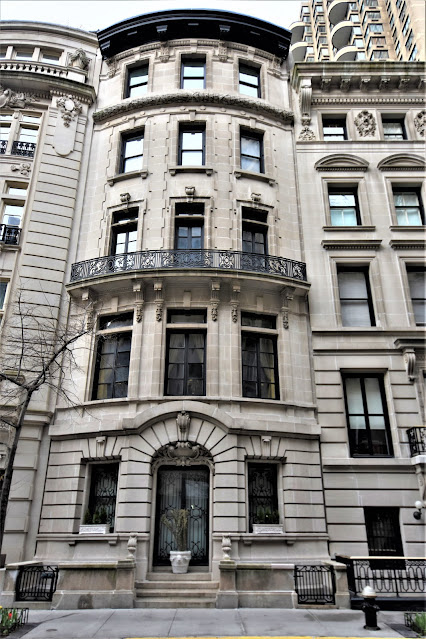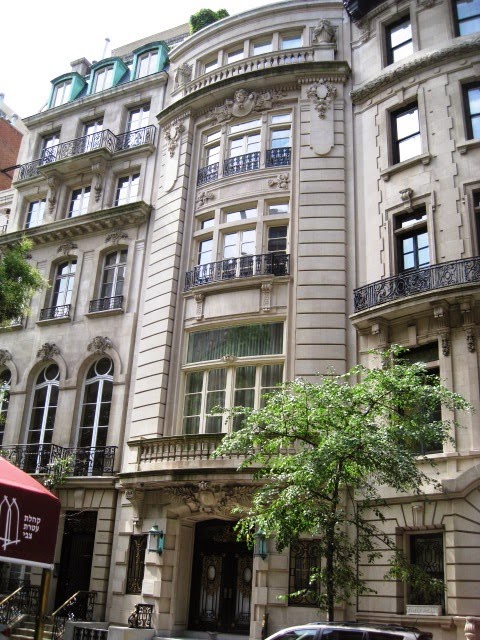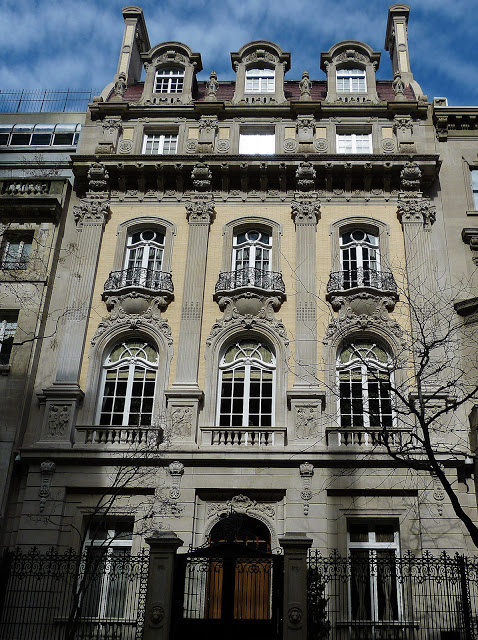Beaux Arts architecture is a New York City staple adapted from the L’Ecole des Beaux-Arts (The School of Fine Arts) in Paris. Popular in the late 1880s to early 1920s, many of today’s buildings still bear the elegant style’s hallmark: “Roman architecture with a lot of sculptural Baroque ornament on top.” Here are some Beaux Arts townhomes on one very beautiful Upper East Side street.
4 and 6 East 62nd Street

The Daniel J. Sully Mansion at 6 East 62nd Street. Photo by Tom Miller of Daytonian in Manhattan.
In 1931, 6 East 62nd Street was internally renovated to be combined with the adjoining #4. Though the Department of Buildings considered the two buildings as “separate buildings under the same ownership” at that time, a 1985 renovation officially merged the two into one, addressed only as #4 under the name Curzon House thereafter.
According to Daytonian in Manhattan, cotton broker Daniel J. Sully and his wife Emma bought the 27-foot-wide, five story, limestone façade home in December 1903 from the sons of former owners Lavinia Newman and Henry Hall, who lived in the former brownstone since its erection in 1880.
Sully’s time in the mansion was short-lived. His cotton empire crumbled by March 1904. The mansion was in Emma’s name, which allowed the couple to stay in the home for about two years before Bertha Andrews, daughter of John D. Rockefellar’s partner Samuel Andrews, moved in with her husband Roy Alvin Rainey in April 1906 with their son Roy, Jr.
In the early 1930s, Rainey “hired architect John Hamlin to combine it internally with the former William A. Read mansion next door at 4 East 62nd Street.”
#4 is steeped in old New York. “On June 8, 1881 James R. Breen and Alfred G. Nason sold their just completed brownstone house at No. 4 East 62nd Street to Henry Albertson Van Zo Post.” Post was a member of the Knickerbocker family and married the former Caroline Burnet McLean after his first wife passed away. “Caroline was actively involved in the Suffragist Movement and on April 24, 1894 she hosted a “parlor meeting” in the 62nd Street house. Her guest speaker was Harriet Stanton Blanche, the daughter of Elizabeth Cady Stanton.”
Post sold the four-story property to William Augustus Read in March 1897, who followed the trend of demolishing the original brownstone to create a lavish limestone building. However, Read’s architect – Clinton & Russell – bucked the Beaux Arts style and instead created a “neo-Italian Renaissance style, the sedate design featured arched pediments over the fourth-floor windows and massive carved lions’ heads between the top floor openings. French doors at second floor opened onto an iron-railed balcony.”
Today, numbers 4 and 6 are known as Curzon House – a 13-unit, full-service condominium – are essentially the same as their turn-of-the-century builds on the exterior.
Advertisement
8 East 62nd Street

The Van Norden Mansion at 8 East 62nd Street. Photo by Tom Miller of Daytonian in Manhattan.
Constructed by the architect of Grant’s Tomb, this 1903, 20-room mansion was built on the site of what was one of eight matching brownstone rowhomes once owned by “real estate man” William H. Falconer and his wife Margaret Culbertson McLean Falconer, the only person at the time who was believed to have crossed the Atlantic on Cunard liners the S.S. Umbria and the Eturia.
When real estate operator Thomas J. McLaughlin purchased the home and hired architect John H. Duncan who then demolish the old brownstone and built an American basement design entryway with “double doors with heavy French grillwork … within a deep recess under an exquisitely-carved address cartouche surrounded by palms and ribbons. Duncan provided a balcony for every floor, with either carved stone or handsome iron railings; each accessed by French doors.”
The mansion was sold in 1904 to Warner Van Norden, President of the Van Norden Trust Company, for what would amount to $7 million today, according to Daytonian in Manhattan. The residence passed through several tenants from 1915 to the early 1940’s, including Joseph P. Grace of the chemical company W. R. Grace & Co and the wealthy socialite family of Alexander Manson family.
Famous jewelry collector Mrs. George Washington Kavanaugh (nee Maria Miller Haberle), who owned the Beaux Arts building next door at 10 East 62nd Street, is said to have purchased #8 in the early 1940s to protect her investment. But by 1946, #8 was “converted by architect James E. Casale. There was now a doctor’s office on the first floor, a duplex above, followed by two apartments on the third floor, one on the fourth, and two on the fifth. Shortly thereafter author Thomas O. Heggen and actor Alan Campbell took the duplex apartment. Tragically, on May 19, 1949 Heggen was found dead in his bathtub.”
The townhouse was featured in Someone to Watch Over Me in 1978 and sold to real estate investor Keith Rubenstein in May 2007 for $35 million. Rubenstein placed the prime listing back on the market in 2016 for $84.5 million and again in December 2018 for $79.5 million. The 15,000 square foot mansion is currently available for $65 million and offers 6 bedrooms, heated floors, a rooftop terrace with views of Central Park, Zen rock garden, snow melt frost sidewalks, and a dining room spanning one city block.
9 East 62nd Street

9 East 62nd Street. Photo by Flickr user Eden, Janine and Jim.
There does not seem to be a lot of historical information available about #9 on East 62nd Street. Christie’s and Douglas Elliman both place the year of construction as 1867 while Streeteasy and Compass report 1900. The distinction might be that #9 was also demolished around the turn of the century, converted from a brownstone to a Beaux Arts beauty like most of its neighboring properties.
The six-story property is now a condominium, with four separate residences. One of these residences is actively listed for rent, available on September 1, 2021, for $16,000/month. This penthouse offers a private rooftop deck, southern exposure, and wood-burning fireplace in the den of this three bedroom, three bath duplex.
Advertisement
10 East 62nd Street

The Edmund L. Baylies Mansion at 10 East 62nd Street. Photo by Tom Miller of Daytonian in Manhattan.
Billed in 2015 as a little slice of Versailles, the pedigree of occupants at 10 East 62nd Street is equally as grandiose. Like its former brownstone neighbors, #10 was demolished in 1905 in favor of today’s current Beaux Arts design.
Edmund Lincoln Baylies and family moved into the six-story, limestone building in 1907. Baylies, related to the Hamiltons (yes, those Hamiltons) and the politically prominent Livingstons. Though his 1902 business card bears no distinct profession, Baylies was an attorney, including personal counsel to Cornelius Vanderbilt III, and served president of the Vanderbilt Hotel Corporation, a director of the Metropolitan Opera Company and the Eastern Steel Company, and vice-president and trustee of the Green-Wood Cemetery.
Baylies was married to wife Louisa Van Rensselaer. She was from an equally distinguished family, her genealogical roots tracing back to the Rutgers family and to William Paterson, the second governor of New Jersey and future justice of the United States Supreme Court. Van Rensselaer was awarded the Legion of Honour in recognition of her work for France during the Great War, according to Wikipedia.
Louisa was the sole beneficiary of Edmund’s estate when he passed away in 1932 at 10 East 62nd Street, according to Daytonian. She sold it to the Kavanaugh’s, who owned #8 next door. It appears that the Gilded Age home remained in the Kavanaugh family until 1973 when the Fleming School “purchased the mansion for $4 million. Alterations, completed in 1974, converted the interiors to classrooms. As was the case with other exclusive private girls’ schools, however, much of the opulence of the former mansion was carefully preserved. The school remained until 1994 after which the house was converted to three apartments, a triplex and two duplexes. The triplex was put on the market in 2020 for $55 million.”
In 2020, the townhome was divided into three separate residences: a triplex, a duplex, and a penthouse. Streeteasy reports a sale in March 2021 at just below $50 million for the 10 bedroom, 13+ bath, 14,750 square foot mansion.
11 East 62nd Street

The Fabbri Mansion at 11 East 62nd Street. Photo by Alice Lum of Daytonian in Manhattan.
Two blocks from the Japanese Consul General at the Beaux Arts building at 4 East 67th Street is the Japanese Ambassador to the United Nations at 11 East 62nd Street. This 1899 mansion “brought France to 62nd Street” when Margaret Louisa Vanderbilt Shepard gifted it to her daughter Edith S. Fabbri, great granddaughter of Commodore Cornelius Vanderbilt.
Edith and husband Ernesto Fabbri – head of the Society of Italian Immigrants – leased the home to “railroad mogul Edward Henry Harriman and his family for the winter season of 1906-07” when the Fabbris were in Europe after Ernesto’s work in the financial industry was transferred there, the Daytonian reports. The Fabbris leased to businessman and Lusitania victim Alfred G. Vanderbilt in September 1910 before leasing to the C. Ledyard Blairi in the winter of 1911 to 1912.
Charles Steele and Nannie French Steele, partner in J.P. Morgan & Company and that law firm of Seward, Guthrie & Steele, purchased the home from Edith in 1912. After Nannie passed away at the home in 1932 and Charles in 1939, “the townhouse was taken in foreclosure by the Bowery Savings Bank [in 1941]. It was purchased in 1943 by the Johnson O’Connor Research Foundation, known for its aptitude testing.”
After it was listed for $30 million in 1997 by the Foundation, the Fabbri mansion sold for $21 million to the Japanese government in January 1999. Michael Jackson was rumored to be a potential buyer for the 17,214 square foot mansion.
Did we miss any 62nd Street buildings worth noting?






How did the writer “tragically” die in his bathtub?